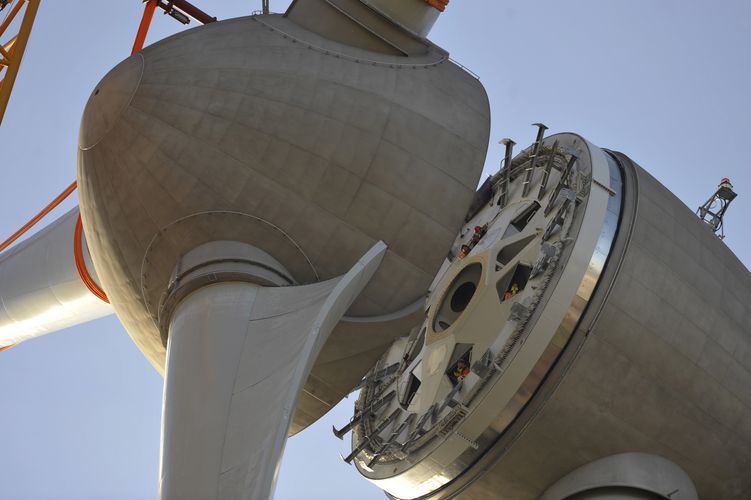Ballooning European sovereign indebtedness, higher capital requirements for banks and the demise of the traditionally crucial insurance-backed funding model have created a vacuum in the infrastructure financing market. Capital markets have long been seen as the natural source of funding if the right instruments could be developed. Will the EIB’s new project bonds help that vision be realised?
To see the digital version of this report, please click here.
To purchase printed copies or a PDF of this report, please email gloria.balbastro@thomsonreuters.com.
Investors have always been interested in infrastructure, even if it has been difficult translating that into allocations. For some, notably insurance and pension fund institutions with their long-term liabilities, its implied payment profile looked particularly appealing.
“Infrastructure constitutes strategically important assets, utilities, services and primary industries fulfilling major economic and social needs,” said Neil Griffiths-Lambeth, who leads Moody’s project and infrastructure finance team. “The sector is characterised by inelastic demand for outputs or services, potentially underpinned by natural monopoly assets that support predictable and resilient long-term revenues. These are highly prized traits amongst investors.”
Yet ratings restrictions and some investors’ lack of confidence in their ability to understand the risks involved prevented many from participating.
The problem was principally one of confidence, acknowledging the many risks associated with infrastructure projects. The European Commission’s solution was the Project Bond Credit Enhancement, offered in conjunction with the European Investment Bank, which was launched as a pilot scheme in 2012, running to 2020.
PBCE was designed to channel financing towards large-scale infrastructure projects in the transport, energy, and information and communication technology sectors. The Commission estimates those sectors have financing needs potentially running to €2trn by 2020.
Under the scheme, bonds are issued by project promoters, with the EIB providing credit enhancement, translating into a ratings uplift, for extra investor comfort. The EIB retains influence over decisions concerning the project alongside promoters, bringing to bear its previous experience in infrastructure financing.
Debt is effectively divided into senior and subordinated tranches, with the subordinated PBCE tranche underlying the senior debt. This can take the funded route in the form of a loan, or use a standby credit facility in the form of a contingent credit line, drawn if revenues are insufficient to meet payments for senior debt, from the EIB/Commission. This support is given at the outset and lasts the full duration of the project.
Project bonds are funded by €230m of EU budgetary resources from unused budget lines for existing programmes, and will finance infrastructure projects worth €4bn across the three sectors. The eligibility criteria requires that projects demonstrate the ability to reach financial close by the end of 2016 and be trans-European. Upstream project preparation work can also be considered.
Based on a positive interim evaluation in 2013 and subject to the final evaluation of the pilot phase in 2015, the Project Bond Initiative is expected to be fully rolled-out within the Connecting Europe Facility, forming part of the 2014–2020 Multiannual Financial Framework.
Kick-starting the market
“Infrastructure developers needed a game-changing development and that is what we hope we have provided with the PBCE,” said Nick Jennett, director of new products at the EIB.
“The EIB’s credit assessment process is very rigorous, so that gives considerable comfort to certain types of investors, on top of the credit enhancement itself,” said Katrina Haley, head of structured bonds at HSBC. “To have the EIB beneath you in the capital structure should be very reassuring.”
The first projects have already received funding and there are more in the pipeline. PBCE’s inaugural transaction was Spain’s Castor underground gas storage project, which was approved in July 2013, to provide storage for 30% of Spain’s daily gas consumption. The EIB will provide a total of €500m for the project, which is being developed by ACS Group and Dundee Energy and the promoter is the Spanish Ministry of Industry. A €1.4bn bond issue was supported by a €200m liquidity line, with the EIB also purchasing €300m of bonds as an anchor investor.
The Greater Gabbard offshore transmission link also received PBCE financing, with bonds valued at £305m issued to finance a new transmission link connecting the 140 turbine wind farm off the Suffolk coast with the UK mainland electricity grid. The EIB provided a £45.8m guarantee, representing 15% of the bonds issued, resulting in a one-notch upgrade in Moody’s rating to A3. The Greater Gabbard OFTO bonds have a maturity of 2032.
“Moody’s has given ratings uplift in excess of two notches for the benefit of the EIB PBCE in projects with construction risk that are exposed to potential delays and cost overruns,” said Griffiths-Lambeth. “For the Greater Gabbard OFTO project, which is already operational, the rating uplift was a single notch,” he said.
The idea is also gaining traction elsewhere. The Asian Development Bank is running a similar scheme in Asia, while even inside Europe the UK government has a similar mechanism in place for domestic projects.
“Involving private-sector investors in infrastructure financing is to be welcomed from a market order point of view,” said Deutsche Bank in a research note. However, Deutsche’s praise for the initiative was qualified, with the cyclical effects of the scheme dismissed as “negligible”, given the small size of the investments.
The bank also warned that the scheme was unlikely to help achieve the political goal of reducing the economic disparities within the EU, because countries with poor infrastructure are less likely to have commercially feasible projects to finance. It added that PBCE might be awarded for reasons that were not purely economic, if politicians saw it as a tool to push through popular but unprofitable projects.
“The EIB’s remit is set by politicians so its agenda is by definition political, but I don’t doubt it will do all the appropriate due diligence to ensure any project it enhances satisfies the relevant criteria,” said Griffiths-Lambeth.
Confidence is back
While it might be an exaggeration to say the advent of PBCE alone reinvigorated infrastructure financing, it certainly contributed to a reversal of fortunes for the market, which has looked far healthier in recent months.
“The market has moved on since last year,” said Haley. “PBCE helped to kick-start the market and set a precedent, since then we have seen confidence building and now investors are more comfortable investing in these kinds of deals, even without the credit enhancement.”
In particular, a number of recent private placement deals, and the emergence of a new class of investor such as infrastructure funds, had dramatically changed the dynamics of infrastructure finance compared with where it was when the EC and the EIB first conceived of PBCE, said Haley.
There are deals are unwrapped, such as the M8 Motorway in Scotland, or wrapped with a UK government enhancement, such as the Mersey Gateway. “It may look like banks have become disintermediated by the emergence of these private placement deals but that is not the case,” said Haley.
“Sponsors need to consider all their options to ensure they are getting the best price. As more products become available for financing, these kinds of deals banks are needed more than ever to advise which option is going to work best for a certain project.”
The result is an emerging suite of financing options to suit a variety of situations.
“The PBCE will be useful for certain situations where other options are less appropriate, [such as] when a project involves weaker contractors, difficult sectors or peripheral countries, and investors need that extra layer of comfort,” said Haley. In other situations that added comfort might not be required and some investors might prefer to invest without the enhancement if they are looking for more yield.
“The standby liquidity feature of the PBCE instrument is particularly suited to greenfield projects, which are subject to construction risk,” said Cormac Murphy, head of division for project bonds and structured finance at the EIB. “More generally, we see growing investor interest in the greenfield area and expect a good mix of projects going forward with the support of EIB credit enhancement.”
The growth of PBCE has left the EIB with a dilemma in that the programme puts them in competition with its own lending arm, yet this needn’t be a problem.
“Banks can provide senior debt to projects but they may also act as advisers or arrangers for capital markets issues,” said Adrian Zambrano, responsible for project bonds and structured finance at the EIB.
The EIB itself can support the two different options but will also focus on the bond solution when it is capable of delivering value for money. For the A11 Motorway project in Belgium, the EIB presented both options and the Public Authority and sponsors opted to take the bond solution with EIB credit enhancement after a funding competition. There is no one-size-fits-all and it is healthy for the market to offer a range of options so developers can pick whichever one suits their own particular circumstances.
“The projects we have done so far demonstrate that PBCE offers good value from a price perspective – better than might be available commercially in some cases – and deliverability,” said Murphy.
“The Greater Gabbard deal was the first time a bond had been used in the energy transmission sector in the UK. The tight spreads the deal saw in placement represented real value for Ofgem. It also opened up a whole new vista of financing opportunities for their investment programme. I’d be very surprised if we didnt see more PBCE deals in that sector in the future.”
Transport is likely to dominate PBCE issues in the pilot phase, predicted Deutsche Bank, with €200m of the total capital available to finance the sector. There are several economically viable transport projects already in the works that will likely appeal to the EIB, leveraging its experience in the transport sector.
“Motorway projects are likely to dominate, because it is a great deal easier to generate sufficiently strong cashflow to cover the investment costs with them than with railway lines or inland waterways,” Deutsche said.
A further €10m will go to energy projects or come from the energy budget, with €20m financing broadband networks, it added.
The numbers remain modest when set beside the astronomical financing needs of the infrastructure sector in coming years, but there is potential for growth if the pilot phase is successful.
“The EIB has never said it is close to running out of money for this scheme, it is more a matter of finding suitable transactions to enhance,” said Griffiths-Lambeth.
“The value of deals for infrastructure projects currently in the pipeline is limited, but as we emerge from the crisis this is going to change,” said Jennett. “If you look out to 2020 and beyond, the financing needs are going to be huge, in the trillions of euros, so the market needs as many options as possible. It is impossible to say how important a role PBCE will make towards that but there is always going to be a role for credit enhancement.”
For now, infrastructure deals appear to be back in favour, with investors of all sorts eager to get their hands on paper, whether it has a credit enhancement or not. “We’ll see a lot of deals going forward – the biggest constraint is likely to be supply,” said Haley.

